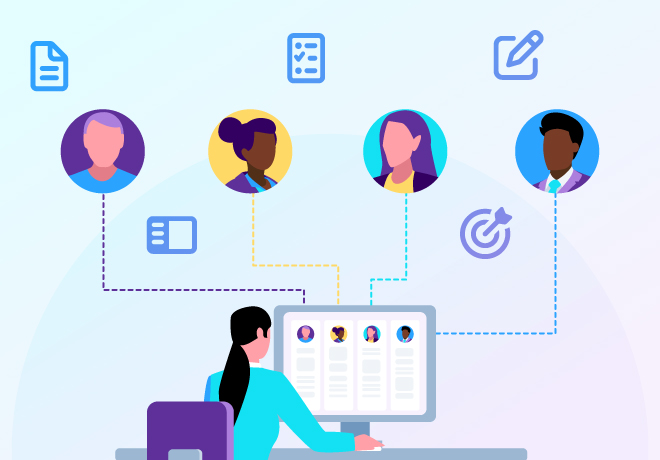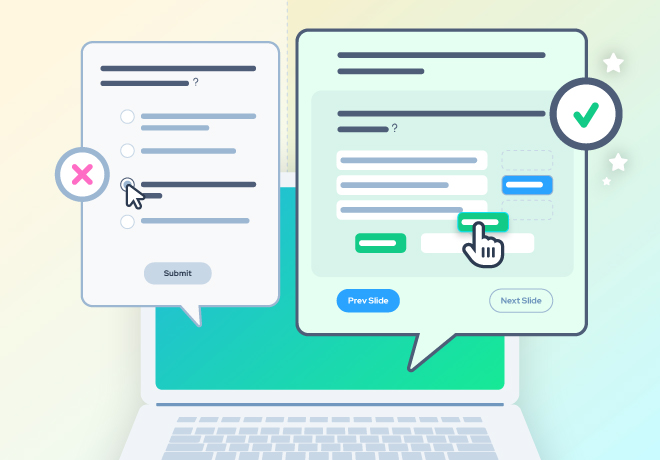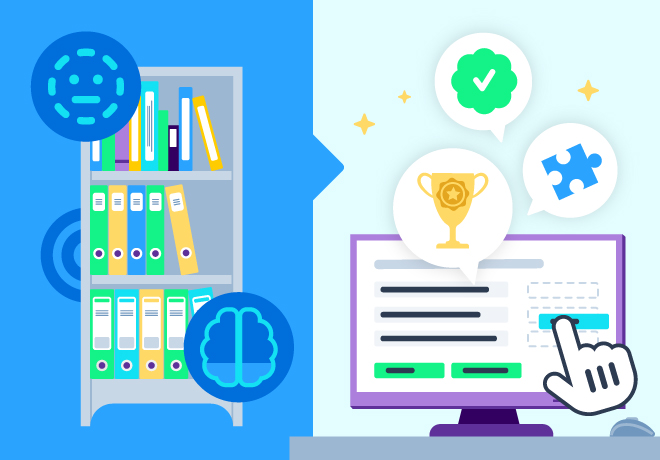
What is gamification in eLearning?

Get valuable eLearning insights to your inbox.
Listen to Neovation’s Demystifying eLearning podcast generated with NotebookLM!
Listen to our podcast on your favorite platform!
Instead of complaining about their annual training and putting it off until the last minute, wouldn’t it be great if learners eagerly engaged with training every day — and talked about their progress toward mastery goals with their coworkers?
Designers often turn to gamification to transform mandatory or information-dense training from a chore into an engaging and even fun activity. Gamification means applying game mechanics to learning content, things like levels, points and rewards.
The idea is that gamifying content makes it fun and engaging, motivating learners to spend more time on their training and get better results.
People love to play

The drive for gamification is rooted in the desire to motivate learners, boost engagement and, ultimately, improve training results.
Games appeal to people of all ages, and online and video games are fast-growing and lucrative pieces of the entertainment pie. Adding game elements to eLearning engages learners for the same reasons that video games, escape rooms, crossword puzzles and other types of game-based learning activities attract millions of people.
Games offer the ability to see, feel and measure improvement in skill or mastery of knowledge by earning badges or leveling up. Game mechanics let learners see their progress, improve themselves and maybe, just maybe, earn bragging rights when they have the top score.
Gamification can enhance eLearning content
Applying game elements to eLearning content — gamification — is often easier, more cost-effective or simply more feasible than creating a learning game. It takes existing content and adds features or fits the content into a game-like framework, rather than creating a new game around the learning content.
For example, if learners have to remember product features, instead of giving them a quiz that simply scores them on their recall of content they’ve just read, provide them with the ability to improve their knowledge over time by using flash cards or a Jeopardy-style game.
While the content might not change, the goal is to make the gamified presentation fun and engaging so learners will spend more time with the content. And that should up the odds that they will learn and remember the information.
What are game elements?

Games are not all about competition. Other elements that can gamify eLearning content include:
- Goals: There’s an objective, whether it’s to achieve Expert-level mastery, know what to do in an emergency or strengthen skills so you can serve customers better
- Feedback: Learners know right away whether they’ve made a correct choice
- Transparency: Players know where they stand and how much progress they’ve made — and how much farther they need to go.
Commonly used game elements include levels, points or badges and leaderboards. These can be used effectively — or not.
Getting gamification right
Not all gamification is effective, especially with adult learners and corporate training. Before proceeding with gamification, you need to know your who your learner is and how they will react to gamified training by conducting learner persona building exercises.
They’re not interested in a gold star or a large number of points; adult learners at work expect learning content to be relevant to their jobs. They should immediately be able to apply the training to do a better job.
Using game elements like leaderboards to fan competition can motivate learners, if they are closing in on a colleague. But public display of scores can humiliate and demotivate lower-scoring employees. It can also cause even mid- and high-scoring employees to give up when they conclude that they cannot possibly win. The problem is turning the focus onto external motivators like public recognition (or embarrassment) and prizes.
It’s also possible, as some eLearning designers have found, to apply game elements and mechanics in ways that boost motivation — while not actually having learners play games.
This approach to gamification:
- Focuses on mastery, not on completion
- Ties progress, whether earning badges or leveling up, to proven knowledge acquisition
- Challenges learners to extend their knowledge, not just to “beat” another team
- Makes it safe to experiment and fail, providing formative feedback that reinforces learning — not punishments like lost points
Whatever form it takes, gamification can help liven up eLearning and induce learners to pay closer attention, spend more time with the content and, as a result, produce better results. Read our new white paper, Gamifying Microlearning … Without the Games, to learn more about game mechanics and other learning, engagement and retention mechanics that build motivation and drive engagement.

An experienced writer, editor, tech writer, and blogger, Pam helps you make sense of learning science and eLearning technology. She provides information you can use to drive improvements in your training effectiveness and ROI.
Become part of our L&D community
We publish a new learning hub article — full of useful, practical topics — weekly.
Not sure where where you want to start? Jump into one of our recently published articles and see where it takes you!








-svg.svg)
-svg.svg)
-svg.svg)
-svg.svg)